

Market Research Proposal
Proposal maker.
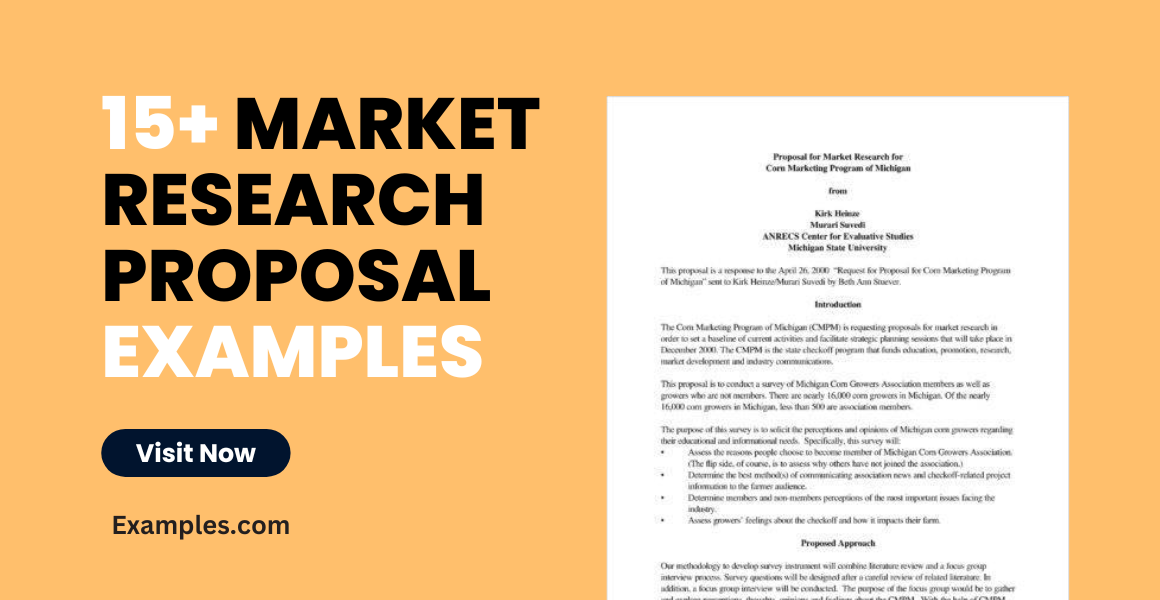
Setting the direction for any market research effort is an essential and critical step that you have to consider whenever you would like to look into the trends in the marketplace or assess the key factors that affect the purchasing decisions of your target audience. Before doing any program or activity related to the specified matter, you first have to know how to execute an effective proposal writing procedure.
Developing a comprehensive and detailed market research proposal can help you a lot in terms of organizing the market research processes that you would like to conduct as well as the resources that you will be needing.
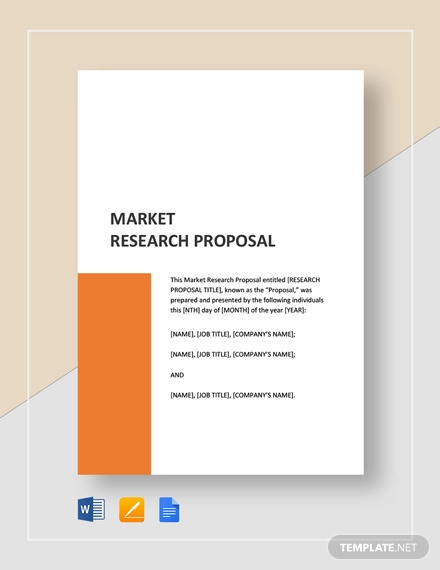
- Google Docs
Size: A4, US
State the objectives, scope of work, research methodology, target market, and other such important information of your market research by downloading and using this above-shown research proposal example template. This ready-made template’s content can be edited and customized in various file formats such as MS Word, Pages, Gooogle Docs, and editable PDF. Hurry up and try it out now!
Market Research Proposal Example
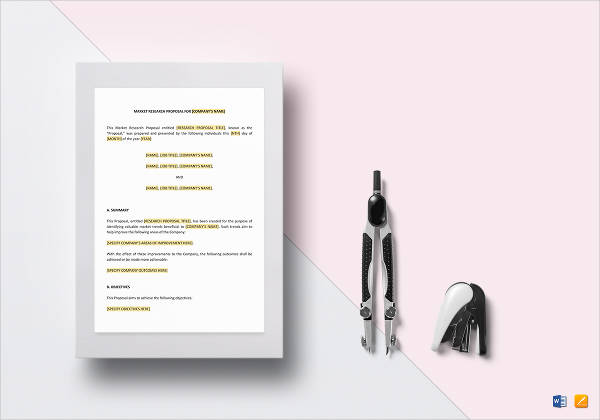
Download and make use of this market research template so that you can conduct your market research effectively. Using this, you can conveniently outline the objectives and goals for your market research, thereby, saving you enough time to do other tasks related to the research. Edit and customize using MS Word and Pages. You can also click on multimedia project proposal examples .
Marketing Research Proposal Example

It is important to not let yourself get confused between a market research proposal and a marketing research proposal. The marketing research proposal deals with the presentation of potential promotional and advertising activities that can be implemented by a company to present and market its products, services, deals, and other offers while the marketing research proposal is focused on learning the market movement based on the market’s trends, activities, and size.
Proposal for Market Research Example
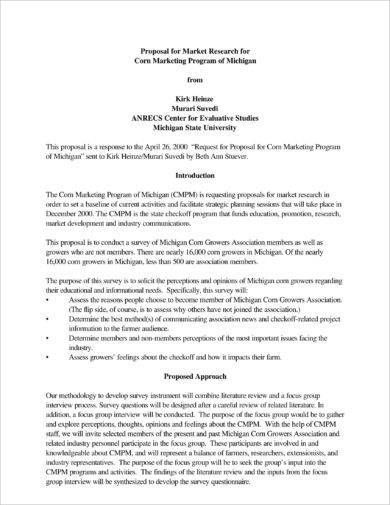
Size: 10 KB
If you want to create your market research proposal, one of the things that you can do to help you have an easier time when developing the document is to look into references like downloadable examples. Simply browse through the market research proposal examples in PDF that are available in this post so you can have an idea of how to properly create the best market research proposal for your business.
Free Market Research Proposal Example
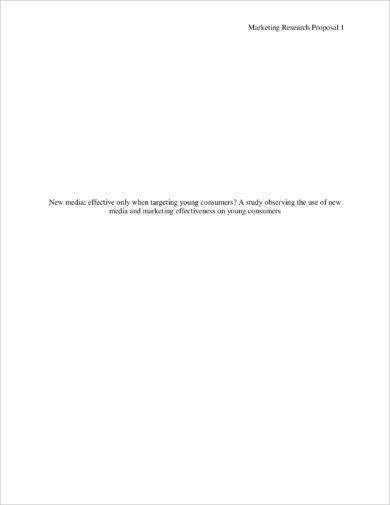
Size: 340 KB
Importance of a Market Research Proposal
A market research proposal helps you properly think of the things that truly matter when it comes to the market research. With the help of this document, you can give priority to the factors and elements that can contribute to the advancement and growth of your business .
Using a market research proposal can also give you time to put together relevant and necessary processes that are most likely helpful in achieving not only the goals of your market research activities but the corporate goals of the business as well. Here are some of the reasons why you need to create and use a market research proposal:
1. A market research proposal is one of the most essential documents that are used by businesses to properly plan the entire process of their market research activities. It presents the outline of the market research’s goals and it also focuses on the action plans that can lead the business to the achievement of its objectives and vision.
2. A market research proposal can give an idea about the funding that is needed by the team to execute the activities for market research. Financial support from the organization is needed to be addressed to make sure that all plotted procedures will be implemented accordingly. You may also see business proposal examples .
Developing the market research proposal with the knowledge that funding will be given for its implementation can make the marketing team, as well as the other people involved in the activity, become more proactive and efficient as it is most likely that what they envisioned and planned will be realized.
3. A market research proposal, especially one that contains a marketing SWOT analysis and a market condition overview, can help you look into the external and internal factors that affect your business operations.
The knowledge about the nature of your business, the competition that you need to look out for, the threats and risks that you need to prepare for, the needs and demands of your audience, the movement and shifts in the marketplace, and the opportunities that you should grab can make you become more well-rounded and multifaceted when drafting the market research proposal that you would like to present. You may also check out project proposal examples .
4. A market research proposal can discuss the milestones that are expected to be achieved by the business with the help of market research strategies and general action plans . Hence, this document can persuade and convince its target audience that a proposed market research activity must be approved especially if expected results can excessively benefit the business or provide a solution to its current issues, problems, and concerns.
Sample Marketing Research Proposal Example
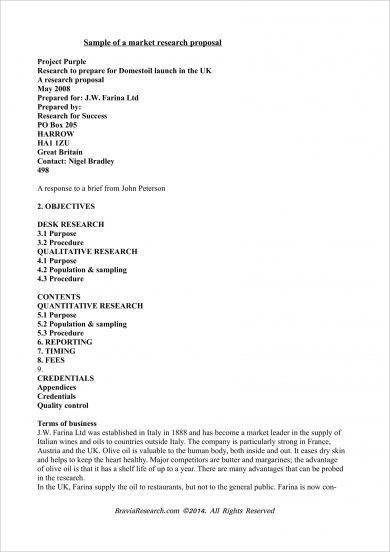
Size: 90 KB
Proposal for Marketing Research and Market Intelligence Example

Size: 607 KB
Market Research and Analysis Report for Proposal Referencing Example
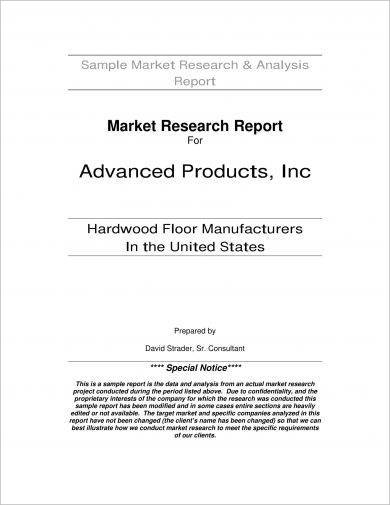
Size: 152 KB
Market Research Proposal Content
Different market research proposals have different sections, clauses, or areas of discussion. The content of a market research proposal depends on the purpose of its usage, the scope of the activity, the expected returns of the business, the professional goals of the market research, and the relation of the document’s usage to the vision of the business.
Even if there are differences when it comes to the information that you can see in many market research proposals used in various industries, there are still common or usual information that is seen in any market research proposal. Some of the details that are essential to be included in a market research proposal are as follows:
1. Develop a hypothesis. This is very important as you need to present the potential impacts of the market research proposal when implemented. This can also help you identify the ways on how you can interlink or align all the elements that are essential for the successful execution of all the market research proposal’s areas. You may also see short proposal examples .
2. Present an overview of the market research activities that you would like the business to consider. You have to sum up the intent of the market research as well as the output that you expect from it. More so, you have to discuss the feasibility, attainability, and sustainability of your general plans . Being able to showcase these strengths can help your market research proposal become more appealing and relevant.
3. Just like when making a development project proposal , use a timeline that can give an idea of the entire duration of the market research proposal’s actual usage. You have to set time frames where specific deliverables should be seen or observed already. With this, you can ensure your target audience that the proposal is time-bound and realistic.
4. Especially if you will use technical terms, a proper definition of terms is highly suggested to be included in your market research proposal. This part of the document can make the general proposal more understandable for any reasonable person.
5. Know your targets so you can easily come up with the methodology that is relevant to your needs. All the practices and activities that you would like to immerse in should be thoroughly defined in the document so that the general analysis of the measures of your proposal can be objectively done.
6. Discuss the current market conditions in the marketplace where your business belongs. Aside from the trends that you need to consider, you also have to list down the opportunities that the business can take to help it achieve its goals and return of investments.
Marketing Information Management System Research Proposal Example
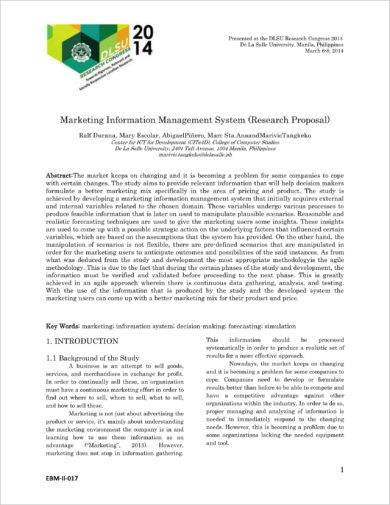
Size: 399 KB
Research Proposal Usable for Market Study Example
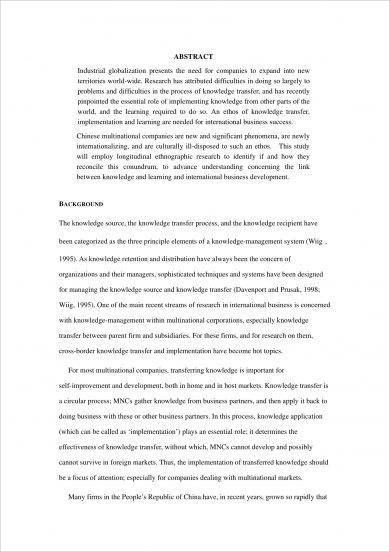
Size: 99 KB
Market Research and Developing a Marketing Plan Proposal Example
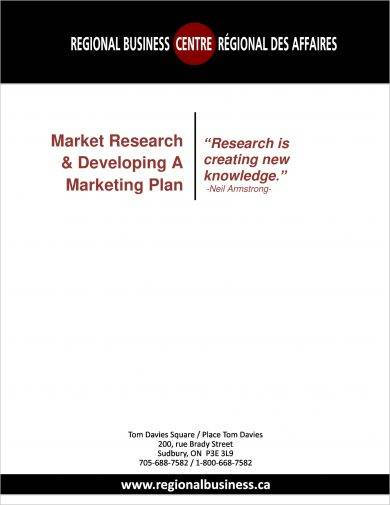
Market Research Conduct and Proposal Drafting Example
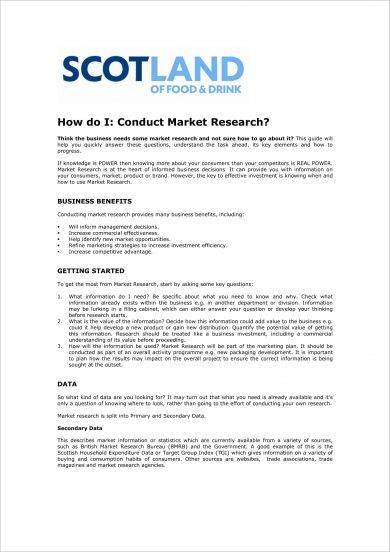
Size: 131 KB
Discussion Flow for a Simple Market Research Proposal
The format and discussion flow of the market research proposal can contribute to the document’s successes, or the lack thereof. This is the reason why you have to be careful with how you will present the market research proposal to your audience. You have to ensure that the document is visually pleasing and well-organized so that people will not have a hard time reviewing its content. You may also see freelance proposal examples .
A basic discussion flow that you can use when presenting the details of your market research proposal are listed below:
- The title of your market research proposal sample
- The date when the market research proposal has been made and the dates of its updates
- The name of the company who can benefit from the document
- The name of the person who prepared the proposal and the department or division where he or she is assigned at
- The executive summary of the market research proposal
- The objectives of the market research proposal
- The current condition of the business and the market as well as other important existing knowledge
- The expected output of the document’s usage, when approved
- The demographics targeted by the business with the help of the market research proposal
- The processes of data gathering, collection, assessment, and presentation
- The methodology that will be applied for the research project plan intended for a particular market
- The dates and periods where particular tasks should already be done
- The budget proposed by the team or the individual who made the proposal
- Any ethical considerations that must be looked into before the implementation of the market research
Proposal to Conduct Consumer Experience of Care Surveys or Market Research
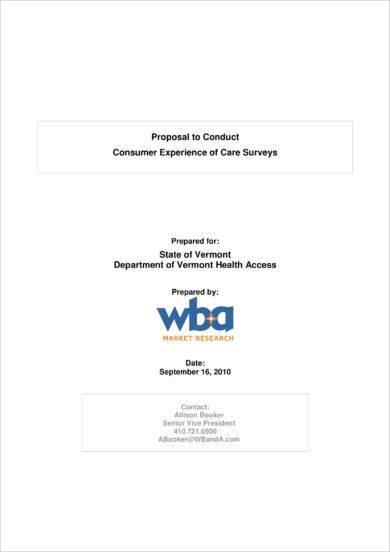
Size: 103 KB
Request for Proposal for Solicitation for Contract for Market Research Example
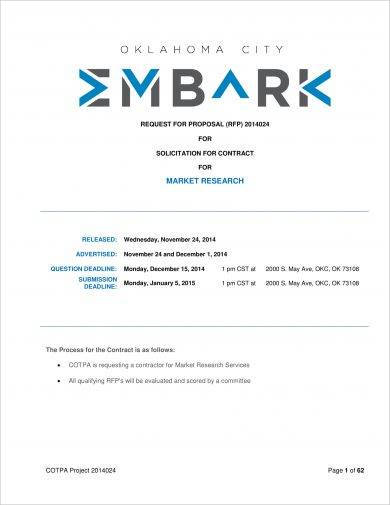
Size: 344 KB
Marketing Research Group Project Proposal Example
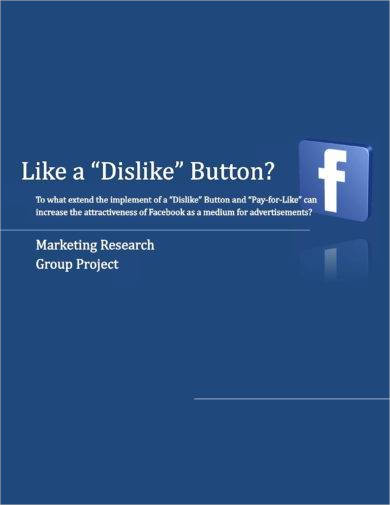
Marketing Research Firm Proposal Example
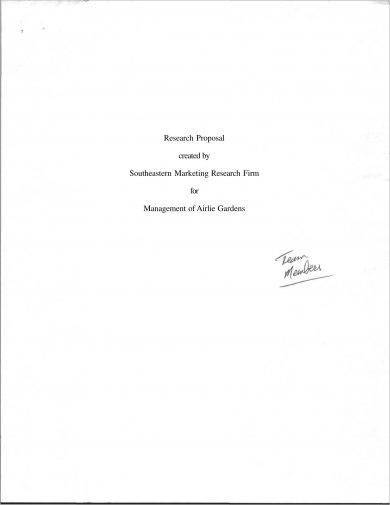
Size: 477 KB
Tips to Develop an Impressive Market Research Proposal
Aside from having an advertising and marketing business plan , you should also have a market research plan. It is not enough for you to rely on your knowledge about the things that you can control. You also have to think of the elements that are not within your hands like the trends in the marketplace and the reaction of your audience and competition with regards to these trends and/or any other market changes.
Listed below are a few of the tips that you can use if you want to develop an impressive market research proposal for your business:
1. Since a market research proposal is one of the first documents that you will be needing for your market research, you have to ensure that the content of the document is flexible enough to adapt to possible changes within the development of the market research planning and implementation phases. You have to ensure that there are windows where appropriate changes can be inserted as well as channels, mediums, or platforms where you can incorporate backup plans when necessary or called for.
2. Keep in mind that the language and tone that you will use when creating the content of the market research proposal must be highly considered.
You have to ensure that the document is formal, business-appropriate, and compelling. Aside from the fact that the market research proposal is expected to be complete with all the details about your proposed market research plan, it is also imperative for you to make sure that the document is understandable, well-defined, and clear. You may also see security proposal examples .
3. Know the basics of market research proposal organization. There are different kinds of structures that you can look into so that your market research proposal can look cohesive and well put together.
The structure of the document should depend on the length of your discussion, the details that you will incorporate in your market research undertakings, and the key factors that you need to give focus and highlight on when presenting the complexity of the market research. You may also like budget proposal examples .
It will rather be more efficient for you if you plan to use references like templates and examples while preparing your market research proposal.
Maximize the help that you can get from the downloadable examples in this post as well as the related discussion that we have presented. Always ensure that there is an organization in the procedures of market research proposal development so you can be well-guided in terms of getting the output that you would like to have for your market research undertaking.
Text prompt
- Instructive
- Professional
Generate a proposal for a new school recycling program
Compose a proposal for a school field trip to a science museum.
- Marketing proposals
Marketing Research Proposal Template
Used 5,031 times
e-Sign with PandaDoc
Prepared by: [Sender.FirstName] [Sender.LastName] [Sender.Company]
Prepared for: [Client.FirstName] [Client.LastName] [Client.Company]

[Sender.Company] is one of the industry's leading firms for marketing research. We specialize in understanding consumer behavior and helping you align your marketing strategy to best capture audience attention.
[Sender.Company] ’s headquarters is situated in [Sender.City] , but we have operations expanding overseas, including cities such as Mumbai, London, Washington DC, Sydney, Tokyo, and Mexico City. Our client list includes noteworthy names, such as (Client A, Client B, and Client C, etc.) , amongst others.
With over (X) years of industry experience, we have learned what makes your audience tick — and what makes them click — and we help you understand consumer behavior such that you can create better marketing strategies, land dream clients, and improve your sales processes.
Client testimonials
Here’s what some of our past clients have to say about our work.
(Client Testimonial 1)
[Client.Company]
[Client.FirstName] [Client.LastName]
(Client Testimonial 2) (Client.Company) (Client.FirstName) (Client.LastName)
(Client Testimonial 3) (Client.Company) (Client.FirstName) (Client.LastName)
The purpose of this research is to understand consumer behavior for the customers of [Client.Company] . We also aim to understand what strategies work for the target mix and how [Client.Company] can improve their marketing strategy to better educate, inform, and persuade their potential clients to buy their products or services.
This research was commissioned by [Client.Company] , and the proposal is therefore created uniquely for [Client.Company] by [Sender.Company] . This ensures both parties are on the same page before beginning the research process. We will be using both quantitative and qualitative research techniques to learn about [Client.Company] ’s target group’s consumer behavior, refining the process as we go, and presenting the most useful results of our analysis.
AIMS AND OBJECTIVES
The primary goal of the study is to gain a comprehensive, 360-degree understanding of consumer behavior with respect to [Client.Company] ’s customer base and target audience.
The study must meet the following research objectives to be considered accomplished:
It should critically examine the target demographic’s behavior.
It should intercept both primary and secondary data to come to conclusive results.
It should address implications of an ineffective marketing strategy.
It should understand what would be the right way to communicate with the target demo.
All other research objectives that the client deems necessary to be included in the study.
Framework analysis
This section goes hand-in-hand with the aims and objectives section, but should focus more in-depth on the background circumstances which indicate a need for the specific market research project proposed. While aims and objectives describe the specific outcomes the research will produce, the framework analysis section should demonstrate the scope of these outcomes from a practical standpoint. The framework analysis should include information from existing sources (the current body of knowledge) regarding the specific topic to be researched. You can then demonstrate the specific need for your proposed research plan.
Existing knowledge
Through secondary research and the previous data we have on the client’s target demographic, we know the following about the client:
Add details about the existing knowledge you have on your target mix.
By conducting this study, we also plan to understand if this knowledge still holds true for our client, and to what degree, within the current economic and social environment.

The hypothesis of the study is that the target audience enjoys [Client.Company] ’s social media posts. However, it does not like interacting with offline events that [Client.Company] conducts, and would ideally like to see more engaging offline events from the brand.

COLLECTION OF DATA
Use this section of the marketing research proposal to thoroughly describe all data collection methods which will be utilized in your research. The overall strategy can be addressed, as well as the individual data collection methods. For market research, these often include methods such as focus groups, surveys, social networking research, or in-home tests. Be specific about each method. For example, if your research includes the collection of surveys, specify in this section precisely how those surveys will be conducted (via phone, email, mail, etc.), what demographics will be sampled, and what the format will look like. The more detailed you can be in this section, the better likelihood that your proposal will be accepted.
Data collection can be done through many ways, such as client interviews, focus group studies, observation, social media data, online surveys, tests, questionnaires, published studies, public records, etc. Analysts usually use a mix of these data collection methods to understand audience behavior. Still, they may prefer some data collection methods over others depending on if they’re conducting qualitative research or quantitative research.
Target audience
Our target demographic for this study are men between the ages of 30-45, who are present on social media sites like LinkedIn and Twitter. The same target mix also has a spending power of up to (X) dollars per month, enjoys vacationing often, and prefers to buy luxury, high-quality products. They are motivated to buy [Client.Company] ’s products because they like the quality of materials the items are made from and because everything is ethically sourced and created.
Sampling method and size
For the research we’re conducting, [Sender.Company] has decided to explore the probability sampling methodology. Keeping all requirements of the research in mind, we believe that this method would be particularly fruitful to achieve accurate results. With probability sampling, [Sender.Company] plans to employ the stratified random sampling method, and will be using a sample size of (X) , which will be further divided based upon ages of the individuals.
Research methodology
Use this section to discuss the merits of your research methods. Describe the implications of each method of data collection, and explain the methodology you will use to interpret the data. Discuss the means of evaluating the collected data.
Fieldwork and Reporting
Starting from the date when the contract is signed by both parties, [Sender.Company] will begin fieldwork within 10 days. We will create a live data link to share all updates on the project. At every project milestone, [Client.Company] will be updated with a progress report. The link will be shared within 10 days of acceptance of the agreement, and can be accessed through a passcode [Sender.Company] will provide [Client.Company] .
Timeline and Budget
The following tables describe the budget and time requirements projected for the project.
ETHICAL CONSIDERATIONS
Ethical considerations are very important in all types of research. Use this section to delineate the ways in which the research will abide by an ethical code in both methodology and practice. Among other possibilities, address factors such as confidentiality, data security, privacy, and consent of research participants.
LIMITATIONS
This section can remain somewhat brief. Here, you can concede any potential or probable limitations of your research methods.
FURTHER OUTCOMES
Although you have already addressed the likely outcomes of your findings previously in this research proposal, in this section you can expand upon the implications and potential benefits of your intended findings.

Terms and conditions
[Client.Company] agrees to pay [Sender.Company] 50% of the total project fee before beginning the project. The project will begin work once signatures are attained from both parties and 50% upfront payment is received by [Sender.Company] .
Once the project is completed, [Client.Company] is to send the remaining 50% payment amount due within 15 days after the final report is shared. Failure to send payment within the stipulated time period will result in a 10% late fee — this payment is to be made to the (Sender.Client) , unless the deadline for payment is agreed on a different date by both parties.
Any disputes arising from the agreement will be resolved based upon the laws and jurisdiction of [Sender.City] , [Sender.State] , [Sender.Country] .
Both parties agree that the contents and findings of the study will remain confidential, unless otherwise agreed upon. Confidential information is not information that is readily available to the public.
[Sender.Company] is not responsible for any damages arising from the case study unless there has been an error in the way the study was conducted.
[Client.Company] understands that there may be minor delays, not exceeding more than 2 weeks, depending on if the target audience of the study is quick (or not) to respond. Any delay and modifications in deadline will be communicated with [Client.Company] .
[Sender.Company] agrees to provide accurate and truthful information learned from the study. [Sender.Company] is not, however, responsible for the findings of the study. Nor is it liable for any damages arising out of the application of suggested solutions.
Please provide confirmation of agreeing to the terms of this agreement by signing the signature block below.
[Sender.FirstName] [Sender.LastName]
[Sender.Company]
Care to rate this template?
Your rating will help others.
Thanks for your rate!
Useful resources
- Featured Templates
- Sales Proposals
- NDA Agreements
- Operating Agreements
- Service Agreements
- Sales Documents
- Marketing Proposals
- Rental and Lease Agreements
- Quote Templates
- Business Proposals
- Agreement Templates
- Purchase Agreements
- Contract Templates

How to Write a Market Research Proposal [Template + Tips]

Whether trying to win over a new client or impress stakeholders with a fresh strategy, crafting a detailed and persuasive proposal can make the difference between a project that moves forward and one that stalls. You have the skills, the drive, and the expertise. So how do you gain buy-in and convince your audience you can get the job done?
We explore what a market research proposal is, provide a roadmap of how to successfully showcase each section of your proposal, as well as provide tips to elevate your proposal above the rest.
What is a market research proposal?
Firstly, an important distinction: What is the difference between a market research proposal and a marketing proposal? Well, the former is the crucial Step 1 of revolutionizing a client’s business. It’s a plan to conduct research that gathers information about the market, such as consumer preferences, competitors, and industry trends . These might then inform and shape a marketing proposal, AKA Step 2, which will execute promotional strategies.
Our focus here: Step 1. The more rigorous your research proposal, the more your chances are of clinching the role.
Here are the objectives of the project:
- Clarify research goals
- Secure stakeholder approval
- Provide a structured plan
- Manage expectations and align team members
- Justify resource allocation
- Help identify potential challenges
“Market research is essential when it comes to informed decision-making. Without it, businesses may rely on assumptions or intuition, leading to expensive mistakes. It can help identify risks, assess demand, and evaluate competitive landscape” Bleona Bicaj, Senior Market Research Analyst at SlashData
Key elements to include in your market research proposal
Now that we know the end goal, how do we present our case? For a precise and accurate proposal, we’ve laid the foundation, you just need to build on it. Here’s what to include:
- Executive summary
Goals and objectives
Fieldwork and data collection.
- Timeline and costs
The trailer of your movie, this summary gives a snapshot of the whole thing.
It contains a short statement that addresses the problem or proposal and features background information, a concise analysis and a conclusion. An executive summary is designed to help executives and investors decide whether to go forth with the proposal.
A few pointers:
- Hook the reader in the first couple of lines. Highlight how your research will provide valuable insights
- Use active language - choose ‘ will’ over ‘ could’ or ‘ should’ - “Our research will reveal”
- Keep it short and sweet. A weak executive summary that fails to capture the proposal’s essence means there’s a high chance of it getting disregarded.

This section is your compass. Think of goals as the why and objectives as the how . Remember, goals are broad:
- “We plan to uncover competitor strengths and weaknesses”.
Objectives are specific and measurable, so include figures and statistics here:
- “We aim to increase customer satisfaction by 10% within 4 months.”
Here is another example relating to the improvement of product features in a mobile app:
- To refine an existing mobile app by incorporating user feedback to improve its usability and functionality.
- Conduct 200 interviews with current users to identify the most common pain points with the app’s user interface and navigation.
These are your educated guesses, the predictions based on what you think the research will reveal.
A well-crafted hypothesis sheds light on your findings, regardless of whether it's validated, contradicted, or remains uncertain. When formulating it, avoid framing it as a question. Instead, shape it as a definitive statement that can either be upheld or dismissed:
“If we do X, we expect Y.” For example, "Customers aged 25-35 are more likely to prefer online shopping over in-store shopping."
Your hypothesis should be designed to uncover valuable insights. Another thing to bear in mind: Include a couple of hypotheses, but don’t overwhelm. One or two strong ones are better than five vague guesses.
Boost your proposal win rate
Say goodbye to clunky templates and endless revisions. Create polished, interactive proposals in minutes with Qwilr.
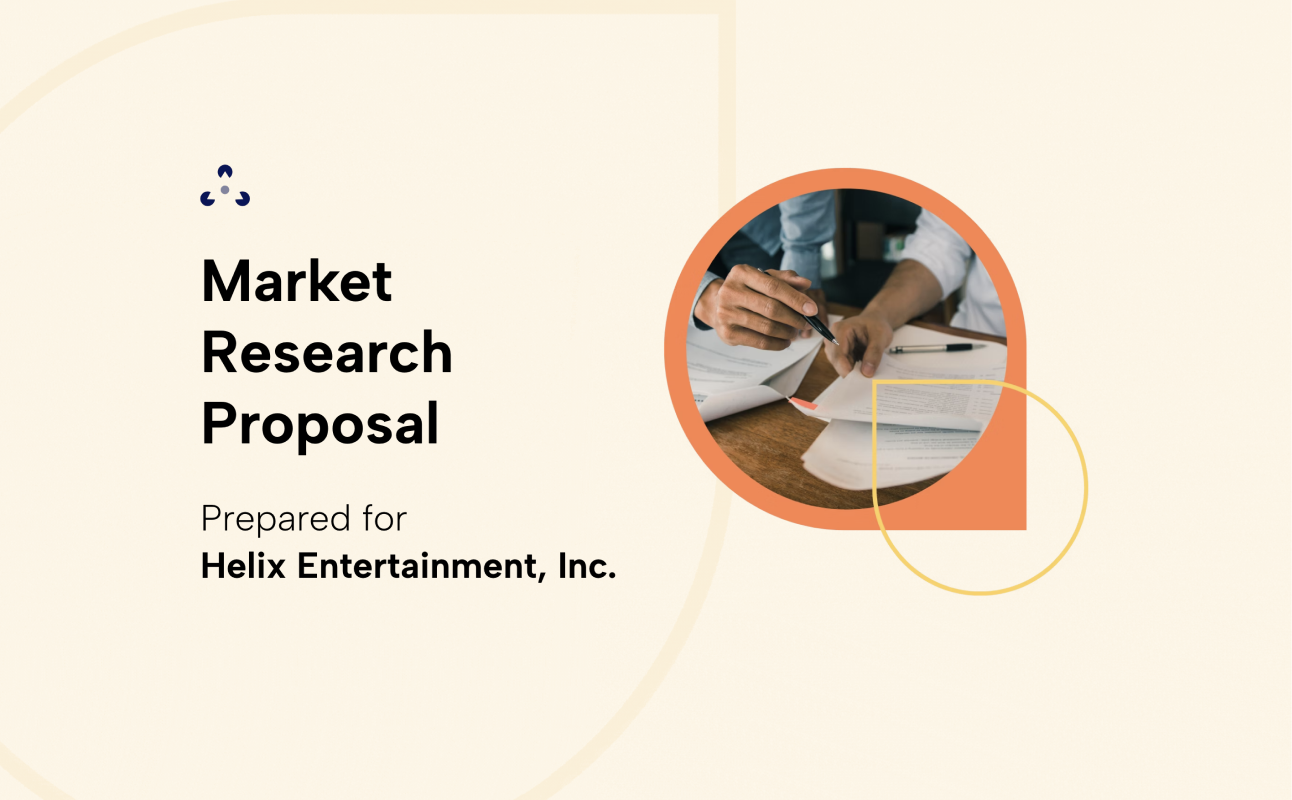
Think game plan. This is where you explain how you’re going to carry out the research, from the techniques you'll use to who will be involved and how you'll analyze the data. Are you opting for either qualitative research or quantitative?
“Qualitative research needs to detail the settings, participants, and the context in which the research will take place. As methods of gathering data, the focus should be on interviews or focus groups, as two examples of qualitative methods, detailing how the data will be gathered. For quantitative, the proposal should specify the survey method, including the sampling techniques, population details, and the type of data to be collected and analyzed through statistical tools and procedures” Bleona Bicaj, Senior Market Research Analyst at SlashData
Think of this as your recipe—what ingredients (methods) will give you the tastiest (most insightful) results? Be clear and logical. Consider including a mix of the two.
Bleona Bicaj , Senior Market Research Analyst at DataSlash, further explains:
“For a more well-rounded picture, mixed-methods research (involving qualitative and quantitative) is a good option. They offer a more comprehensive overview of a given topic, leveraging benefits from both research methods and providing both the "why" and the "how" behind different trends or behaviors”.

It’s time for boots on the ground. Talk about where, when, and how you’ll gather your data. You’ve got the method, now explain how you’ll put it into practice in the real world.
Are you targeting a specific demographic, region, or customer base? Will you conduct online surveys, in-person interviews, or target focus groups? As technology has advanced, so have fieldwork methodologies. They now incorporate telephone interviews, video interviews, social media analytics, mobile data collection, and so on, allowing researchers like you to reach larger and more diverse audiences. So take your pick.
Fieldwork is not without its challenges. Here are some things to look out for:
- Data Quality: Be wary of respondent fatigue, bias, and dishonesty, all of which can seriously skew the research results.
- Ethical Considerations: Fieldwork must be conducted responsibly, ensuring the protection of privacy, informed consent, and careful consideration of sensitive topics—because nobody wants their secrets spilled over a cup of coffee or their personal life turned into a case study without permission! It's not just about ticking the right boxes; it’s about being kind, respectful, and a good human. After all, people are generously sharing their time and stories with us, so let’s return the favor with care and a good dose of empathy.
This paves the way for how long each stage will take and what it’s going to cost. Several factors must be taken into consideration when determining a budget. People want to know you’ve done the graft and there won’t be any surprises along the way.
Bleona Bicaj tells us:
“Several factors need to be taken into account when determining the budget for a market research project. Initially, the research objective (the complexity and the depth of the objectives) is an important consideration. Following that, the target audience and methodology type are important too. For the target audience, harder to reach populations might require additional budget, and for the methodology type, qualitative vs quantitative research methods require different resources. Other than that, we consider factors such as human resources working on the project, the tools we need to use for running the project, data collection costs, etc”
Split the timeline into phases and assign a date, for example:

Include costs for everything: staff, software, travel—be meticulous. And remember, make it realistic. Build in a little buffer for unexpected delays. When it comes to costs, overestimate a little. It’s better to come in under budget than over!
We’ve had a look at how to categorize essential information so that it reads as a practical yet engaging market research proposal. Key takeaways: Be thorough (leave no stone unturned!), be clear in your structure, and include some data-backed confidence.
How to create a market research proposal: Expert tips
The best part about expert tips and advice is that there’s no need to reinvent the wheel. We’ve laid out what works and what doesn’t. Save yourself time and effort by following these tips when curating your research proposal.
Dig into past data or trends to shape your hypotheses
Demonstrating familiarity with industry trends and incorporating historical data adds a layer of analytical rigor. The details matter: show that you can look at past findings before looking at what may lie ahead. Anticipate changes and prepare to provide actionable insights that can guide decision-making.
Know your audience (the pair of eyes reading your proposal!)
By knowing who will read the proposal, you can use language, jargon, and terminology that resonates with them, whether they are technical experts, business executives, or marketing professionals. But, strike a balance—avoid overloading the proposal with complex language that the client may not understand.
Include a competitor analysis
This is a biggie. Benchmarking, identifying market position, and understanding customer preferences are some benefits of including a competitor analysis in your proposal. Consider the ways in which you could present the output.
Bleona Bicaj gives her recommendation:
“One good alternative is through a SWOT analysis (Strengths, Weaknesses, Opportunities, Threats) which outlines what competitors are doing well, where they are lacking, potential threats they pose, and opportunities that they are missing which we can exploit.”
Keep it concise and engaging
Let us be concise in saying this: Avoid the fluff. Clarity over complexity. Less is more. Decision-makers often have limited time to review proposals. A concise document ensures that key points are quickly understood, increasing the likelihood of maintaining their attention throughout the proposal.
Include interactive elements and visuals
Diversify your approach with variety. Use charts, timelines and graphs to visually represent the stages. Infographics, maps, flowcharts, tables, photographs and visual mockups are but a few on the list of scalable and innovative marketing tools to make your proposal aesthetically pleasing and memorable.
To add an interactive touch, consider using QR codes created with a QR code generator to link viewers directly to surveys, supplementary data, or online resources, making your proposal not only visually engaging but also more dynamic and accessible.
By using a web-based proposal tool, like Qwilr , you can easily embed interactive elements—from ROI calculators and pricing tables to data dashboards and videos.

Bring your research to life with Qwilr
No more dull PDFs—transform your market research proposals into engaging web pages that clients can view, interact with, and accept instantly
Include social proof and previous work
If you back yourself, sell yourself.
Be credible! By showcasing previous successful projects or endorsements from reputable clients, you build trust. Be relevant! Highlighting case studies or examples that relate closely to the current proposal illustrates your understanding of the market and its dynamics. Be confident! Testimonials or statistics from past clients can strengthen the proposal, indicating that you have a proven track record.
Personalize your proposal
The stats have been published and the proof is in the pudding. Differentiated proposals are much more likely to be considered as a marketing strategy . Clients are more likely to respond positively to proposals that reflect their specific context and demonstrate your commitment to their success. 89% of businesses are investing in personalization this year. Personal touches can foster a stronger connection and indicate your genuine interest in helping the client succeed.
Market research proposal template
By crafting a compelling roadmap that showcases your strategic thinking, demonstrates your understanding of your client's needs, and outlines exactly how your market research will deliver results, you can reach your career milestones.
All things considered, Qwilr’s market research proposal template is designed to seamlessly streamline the proposal process, allowing you to tailor your project and showcase your brand.
What’s included in the template?
Check out more of Qwilr’s marketing proposal templates here
With Qwilr, you can:
- Customize a user-friendly template to be on-brand and client-tailored
- Adopt innovative design features such as unique brand set-up, styling and template options, and tokens of your choice e.g [Your Company]
- Track engagement on your proposal through real-time notifications and collaborate with others by sharing access to your template and monitoring analytics
Grab our market research proposal template
Present your research findings in a compelling way with our customizable, interactive template
Wow prospective clients with engaging proposals
Conducting market research is essential for gaining insights into target audiences and their preferences. It plays a crucial role in identifying new opportunities and enhancing existing products or services—but none of this matters unless you can get your foot in the door with an impressive market research proposal.
Start streamlining your process with Qwilr, the best proposal software on the market. Sign up for a free trial and take your market research proposals to the next level.
About the author

Brendan Connaughton | Head of Growth Marketing
Brendan heads up growth marketing and demand generation at Qwilr, overseeing performance marketing, SEO, and lifecycle initiatives. Brendan has been instrumental in developing go-to-market functions for a number of high-growth startups and challenger brands.
Related articles
- All articles
- Sales management
- Sales techniques
- Sales enablement
- Customer success
- Product updates

How to Create a Market Research Proposal (+Template)
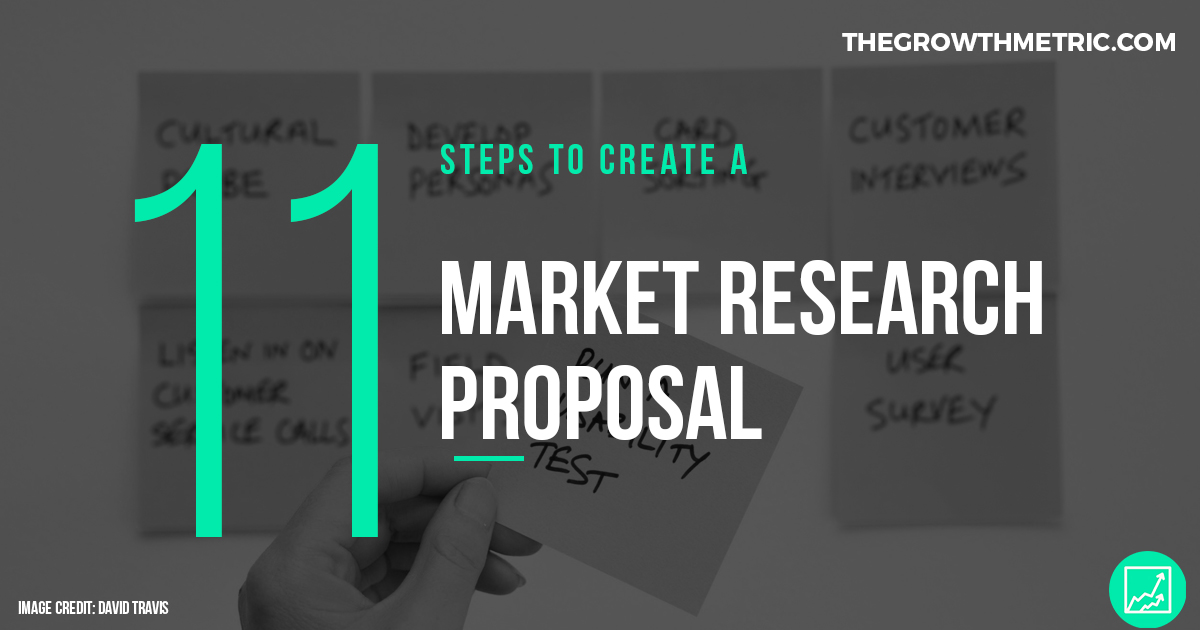
Continuing the market research series, in this article, we’ll discuss what a market research proposal is and how to create one.
To recap, what we’ve covered so far in the series, we’ve talked about what market research is, the different types of market research you need to do to grow your business, and the benefits of conducting market research .
What is A Market Research Proposal
Conducting market research is expensive, and if you work in a large organization, then you would need to justify such expenses.
Before conducting your research you’d need to shed some light on past data about your market, gaps in the data, and why new research is necessary.
This is where a Market Research Proposal come in to play.
Typically, a research proposal is a document proposing a research project, usually, these proposals are done by a scientist or an academic.
The proposals are then evaluated on the cost and potential impact of the proposed research, and on the soundness of the proposed plan for carrying it out. Research proposals generally address several key points:
- What research question(s) will be addressed, and how they will be addressed
- How much time and expense will be required for the research
- What prior research has been done on the topic
- How the results of the research will be evaluated
- How the research will benefit the sponsoring organization and other parties involved
The same principles apply here, only that your business market environment is what is being researched, which is your target market.
A market research proposal is a document that details the what, the where, the when and the how of market research and the information and costs associated with it.
If this sounds complicated, then here’s what you need to know about a market proposal. It addresses:
- Why market research is necessary and what you aim to gain from the research
- What resources are required for the research
- Past research done on your market
- How the data from this market research will be collected, stored and used
- How the research will benefit your business
Keep in mind that at this point you are not conducting the research yet, you are simply providing a rationale behind why market research is necessary.
In the next article in this “Market Research” series, we will discuss the process of conducting market research, but for now, we need to provide a compelling document on why, how, when and where the research will be conducted.
11 Steps to Create A Market Research Proposal

Now that you know what a market research proposal is, it’s time to create one. There are 11 steps to create a sound and compelling market research proposal
1. Market Research Proposal Summary
Start your proposal by briefly explaining the purpose of the market research and why it is required. Also, give an overview of what the desired outcome of the market research is.
If your business is interested in pouring resources into an in-depth market research then surely, there is something you hope to gain from it.
Remember to provide reasoning for the need of this specific market research and let whoever is reading this, such as the CEO, COO. know what contributions this research will make to the company.
TEMPLATE TO USE:
The market research project, entitled [RESEARCH PROJECT TITLE] hopes to discover more information regarding market trends in [SPECIFIC AREA]. The following summary will give an overview of the causes, processes, and possible effects of the market research proposal, detailed below.
2. Research Objectives
In this section of your proposal give full details about what problem has been identified that requires market research to be conducted. I.e. Show why there is a specific need for this research in the first place.
Explain what the market research results will be used for and how they will help achieve the overall goals. Describe the goals which you hope to achieve with this project.
The proposed market research project contains the following objectives:
- Objective one
- Objective two
3. Background Information on Past Market Research
Odds are you’re not the first person/company to conduct research on your market. This means that there is existing information on your market. However, this knowledge might be outdated, or might not provide the data your business needs.
So, in this section explain what information already exists on this topic and what is already known. Also, highlight the gaps in knowledge that the market research will hopefully fill.
Here you will show information from existing sources regarding the specific topic to be researched. It is great to provide cited sources, graphs, charts, and statistics.
You will use this section to show that you know a great deal about the market you will be researching, but you also need to show the holes in the current knowledge.
You can then demonstrate the specific need for your proposed research plan, and how this market research plan will fill these holes and contribute to the knowledge of this subject.
4. Market Research Proposal Hypothesis
If your business needs to conduct market research, then you probably have a few ideas of what you hope to get or learn from the research.
In this section describe what you believed to be the likely outcome of the market research and what you hope to learn.
5. Research Target Audience
Your business doesn’t target everyone, and odds are your business targets different audience types. So who is this research targeted at?
This is a very important part of your proposal and you need to be as detailed as possible about the target audience or audiences you will be researching.
Also, describe how you will source this target audience and how you will ensure they meet the correct criteria.
6. Data Collection of Market Research
Time to get to the good stuff. In this part of your proposal, you MUST detail all the data collection methods that will be used during the market research and, how they will be carried out.
You MUST also explain how the accuracy of data will be maintained, how potential candidates for the research will be approached and, if applicable, how they will be reimbursed for their time and contribution.
Use specifics and consider potential questions such as.
- How will you maintain the accuracy of data?
- How will you approach potential survey or research candidates?
- Will these participants be paid for their time?
- At what times of day will you make phone calls?
- In what ways will you ensure an accurate data sample?
The more information you can provide in this section, the better.
Our methods of data collection will be best suited to the project at hand. Research methods will include:
- Focus groups
- Collection of social media data
- Surveys via the Internet, phone, or email
- Long range in-home consumer tests
- Distribution of samples
- In person promotionals
These individuals will be selected [HOW THEY ARE SELECTED] to ensure an appropriately constituted pool of data from which we can infer accurate insights and trends.
The pool itself comprises of individuals who have expressed to us an interest in participating in such surveys, and they will be compensated by [METHOD OF COMPENSATION]….
7. Research and Analysis Methodology
In this section of your proposal, you are to discuss the strengths and possible limitations of your research methods.
Provide an overall blueprint for your methodology in approaching research data, and describe the implications of each method of data collection, and explain the methods you will use to interpret the data.
Lastly, discuss the means of evaluating the collected data and how you will account for errors, holes in data, or inaccuracies.
8. Ethics to be Followed During Research
You’re almost done with your proposal, but there are still a few important details that need to be included.
Explain how the market research will adhere to ethical codes by thinking about how issues such as participant confidentiality, data security, privacy, and consent of research participants will be addressed.
Include waivers or documents you plan to provide to research participants, if applicable
9. Market Research Timeline
In this section, provide a detailed timeline of when the research needs to begin and when a full report is required, ensure sufficient and realistic time for both data collection and data analysis are considered.
Market Research Timeline
- Task 1 ([DATE] [TIME])
- Task 2 ([DATE] [TIME])
- Task 3 ([DATE] [TIME])
10. Market Research Budget
We’re almost done with our proposal, but it’s time to include arguably the most important section. After all, if your company does not have the funds and resources then there would be no research in the first place.
Provide an overall budget for the proposed project. Make sure to include all possible cost considerations. You can provide a breakdown of those here.
Don’t forget budgets for sections such as Participant Reimbursement, funds for documents, rental space.
11. Conclusion
This is the last part of your market research proposal. You can add ways in which this market research will provide further benefits or include unique applications of the potential results.
Now that you know the market research proposal process and the importance of market research, in the next article will discuss the actual market research process.
Comment with any questions you have about Market Research Proposals and I will get back to you ASAP.

Receive Growth Marketing Resources Directly To Your Email
Join The Growth Metric's mailing list to receive the latest resources and blog posts.
Almost there, click on the confirmation email!
Post navigation, leave a reply cancel reply.
Your email address will not be published. Required fields are marked *
This site uses Akismet to reduce spam. Learn how your comment data is processed .

COMMENTS
Jun 19, 2024 · The marketing research proposal deals with the presentation of potential promotional and advertising activities that can be implemented by a company to present and market its products, services, deals, and other offers while the marketing research proposal is focused on learning the market movement based on the market’s trends, activities ...
A market research proposal is a document that a researcher or a company sends to a prospective client. It usually is a document with well-designed cover page and it contains the description of the market research that the sender proposes, the price for it, and various terms and conditions pertaining to its delivery.
A marketing research proposal is a document that outlines how a company plans to understand consumer behavior. Marketing research firms create this proposal for prospective clients to help them understand how their audience perceives the clients’ current marketing strategy.
Oct 10, 2024 · Firstly, an important distinction: What is the difference between a market research proposal and a marketing proposal? Well, the former is the crucial Step 1 of revolutionizing a client’s business. It’s a plan to conduct research that gathers information about the market, such as consumer preferences, competitors, and industry trends .
May 9, 2023 · Including a timeline in a market research proposal is necessary to ensure the client is aware of how the project will progress. Additionally, this helps to keep the research team aware of deadlines and goals. Estimated cost: Pricing will always be included in a market research proposal. Usually, costs for a project will be a fixed price.
This is where a Market Research Proposal come in to play. Typically, a research proposal is a document proposing a research project, usually, these proposals are done by a scientist or an academic. The proposals are then evaluated on the cost and potential impact of the proposed research, and on the soundness of the proposed plan for carrying ...